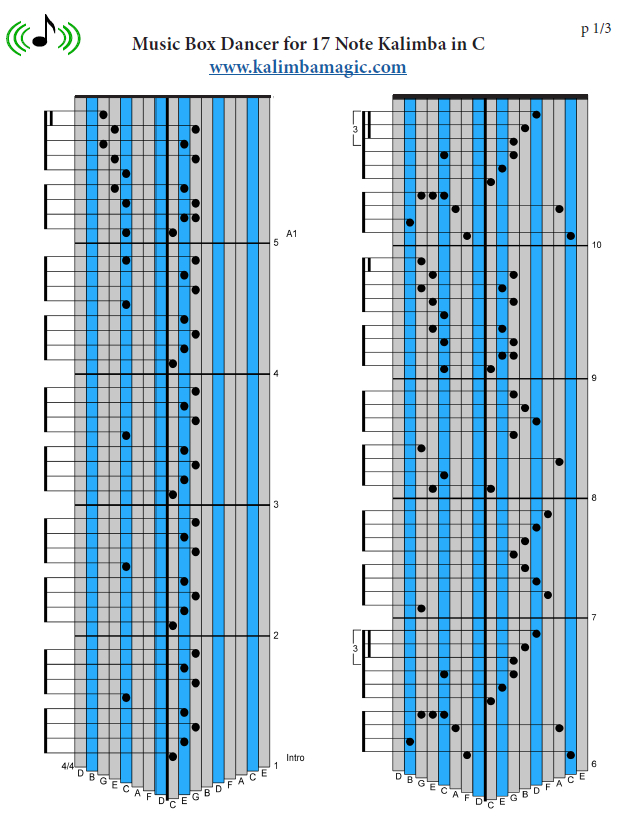A large part of what makes the kalimba such a magical instrument is the nostalgia it creates when you play it. Not always, but often the kalimba will sound like a tiny little music box. You can play that up, by learning some of the famous songs from music boxes: “A Time For Us,” “Over the Rainbow,” or “Fur Elise.”
And an obvious song to add to that list would be Frank Mills’ “Music Box Dancer” – which in my mind was a song that was created to play upon that same nostalgia.
Below is the first page of the tablature for “Music Box Dancer” for the 17-note kalimba in C (that is, the Kalimba Magic Heart-17 (or any of the other new Chinese-made 17-Note kalimbas such as Walter, Gecko, Donner, etc). Click on the image to download the 3-page PDF file. And when you have the PDF, click on the sound icon so your web browser can download the MP3 file that goes with this tablature.

Click on the image above to download the full 3-page PDF with live link to the MP3 file.
If you have an Alto kalimba, you can still read this tablature, as this tab doesn’t specify anything for the top two notes. Keep in mind, you will not be able to play along with the recording, which is in C while your kalimba is in G.
The first four measures are a repeated ostinato introduction. The melody comes in at measure 5. We try to maintain the ostinato accompaniment along with the melody (ie, everywhere there is harmony, one of the harmony’s notes is the ostinato accompaniment, and one is a melody note). At some places, such as measure 7, there is only melody. Of course, take it as slowly as you need to to get the notes to come out smoothly.
Also note the places where there are several fast notes on the same side – like those at the ends of measures 5, 6, 9 and 10. Here, you will have to make a timed glissando, dragging your thumb nail across the two or three adjacent notes. A timed glissando means don’t do it too fast, but in time with the music… that is, as written out with the sixteenth notes or sixteenth note triplets.
Best to you on learning this song.
Oh, and if this song is a bit beyond your abilities? Just start with something easier – such as the songs in “44 Beginner Songs for 17 Note in C” or “Easy Christmas Carols for the 17-Note in C.” Both of those ebooks start out pretty easy and progress to the point that you could jump into “Music Box Dancer.” Links to all the 17-Note resources can be found below.


Sign up for our newsletter and free resources with your email address:
We pinky promise not to spam you and to only send good stuff.
 Christmas in July 2025
Christmas in July 2025 Patriotic and American Music for Kalimba
Patriotic and American Music for Kalimba